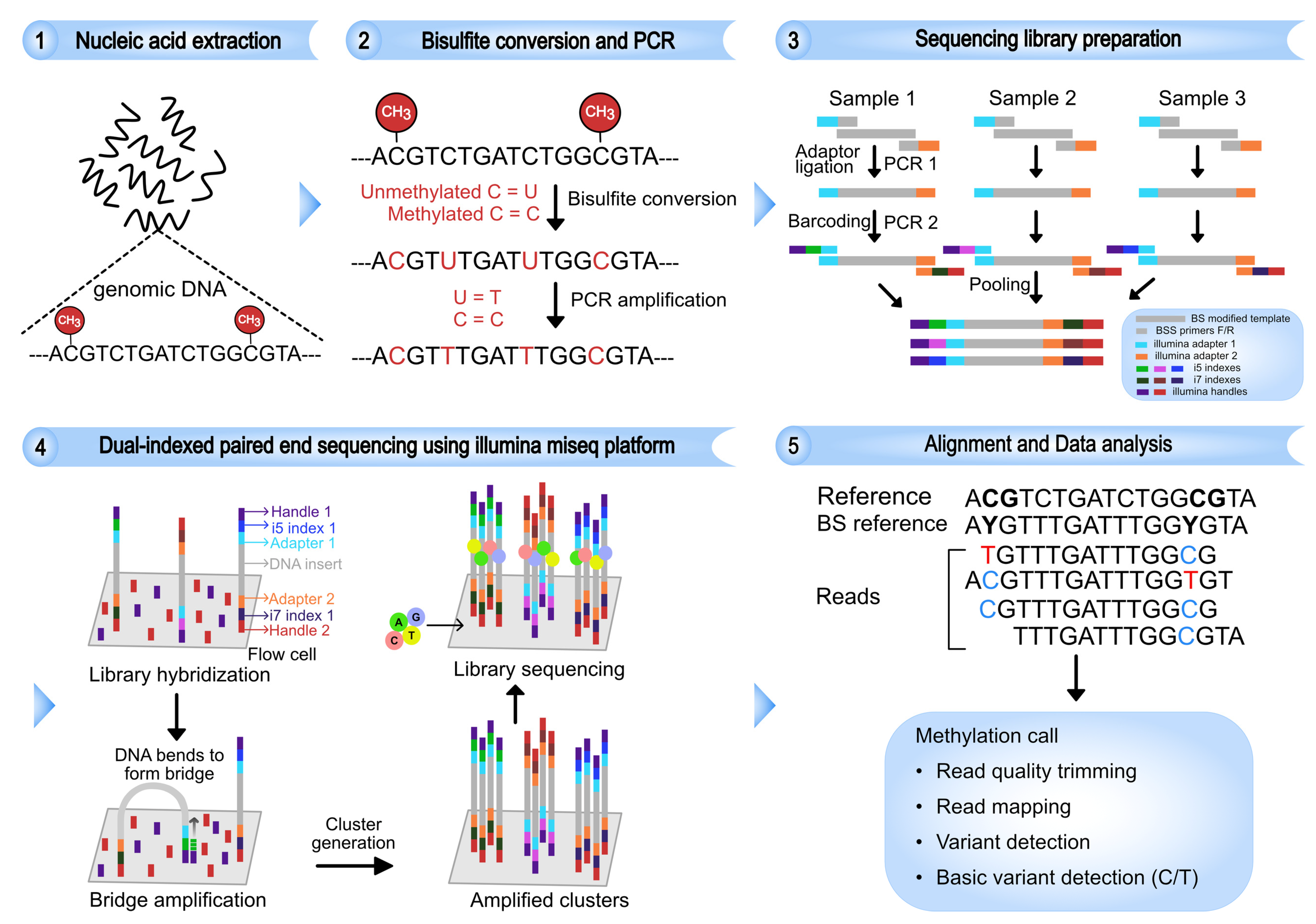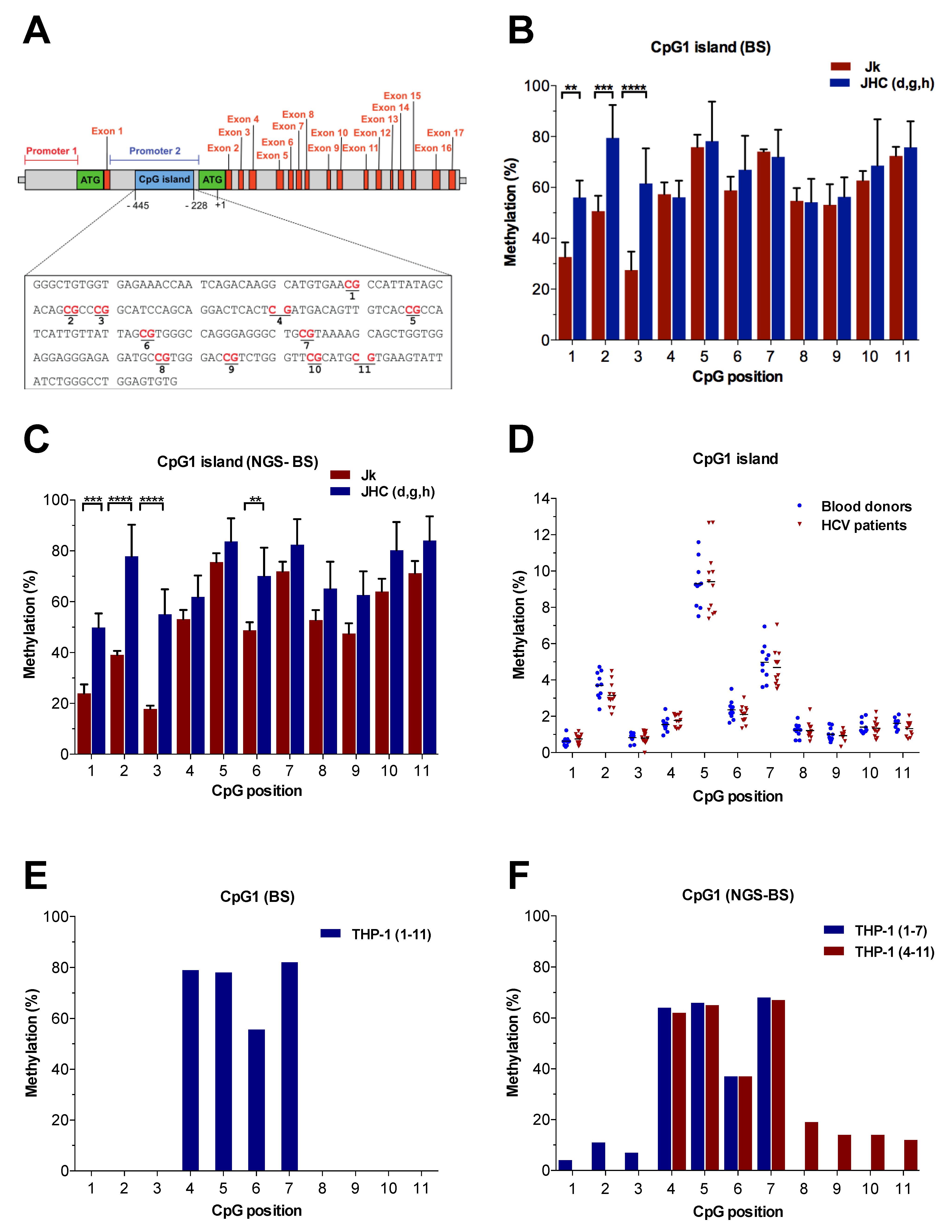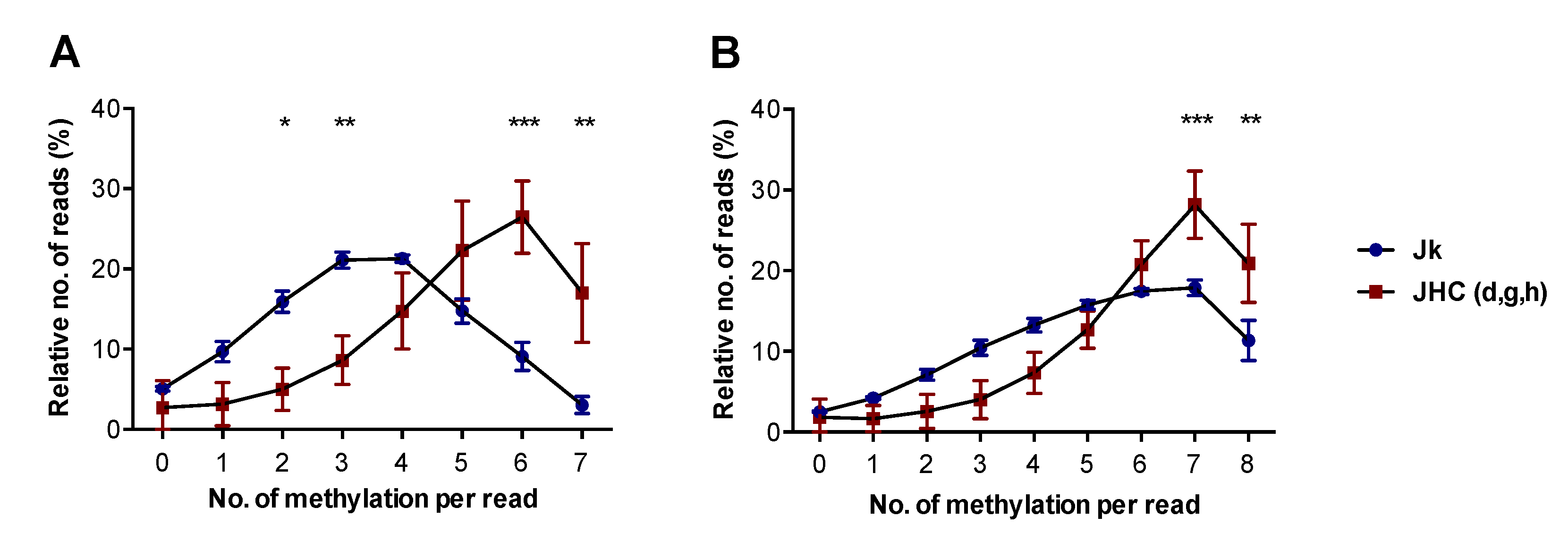Next-Generation Sequencing Analysis of CpG Methylation of a Tumor Suppressor Gene SHP-1 Promoter in Stable Cell Lines and HCV-Positive Patients
Abstract
1. Introduction
2. Materials and Methods
2.1. Patient Samples and Cell Lines
2.2. PBMC Isolation
2.3. Strand-Specific Quantitative RT PCR (ssqRT-PCR) Recognizing HCV RNA
2.4. Real-Time HCV PCR (qRT-PCR)
2.5. PBMC Cell Type Analysis by Flow Cytometry
2.6. DNA Isolation and Bisulfite Conversion
2.7. Primer Design, PCR and Generation of Sequencing Library Using Dual Barcoding
2.8. Next-Generation Sequencing (NGS) and Data Analysis
2.9. Analysis of Methylation Heterogeneity
3. Results
3.1. Quantification of Positive (+) and Negative (−) Strand HCV RNA in Patient-Derived PBMCs
3.2. Cell Type Analysis of HCV+ PBMCs
3.3. Methylation Status of CpG1 Island on SHP-1 P2 in HCV+ Samples
3.4. Methylation Heterogeneity in Cell Lines
4. Discussion
5. Conclusions
Author Contributions
Funding
Institutional Review Board Statement
Informed Consent Statement
Data Availability Statement
Acknowledgments
Conflicts of Interest
References
- Morales-Nebreda, L.; McLafferty, F.S.; Singer, B.D. DNA methylation as a transcriptional regulator of the immune system. Transl. Res. J. Lab. Clin. Med. 2019, 204, 1–18. [Google Scholar] [CrossRef] [PubMed]
- Moore, L.D.; Le, T.; Fan, G. DNA methylation and its basic function. Neuropsychopharmacol. Off. Publ. Am. Coll. Neuropsychopharmacol. 2013, 38, 23–38. [Google Scholar] [CrossRef] [PubMed]
- Luo, C.; Hajkova, P.; Ecker, J.R. Dynamic DNA methylation: In the right place at the right time. Science 2018, 361, 1336–1340. [Google Scholar] [CrossRef] [PubMed]
- Greenberg, M.V.C.; Bourc’his, D. The diverse roles of DNA methylation in mammalian development and disease. Nat. Rev. Mol. Cell Biol. 2019, 20, 590–607. [Google Scholar] [CrossRef]
- Eckersley-Maslin, M.A.; Alda-Catalinas, C.; Reik, W. Dynamics of the epigenetic landscape during the maternal-to-zygotic transition. Nat. Rev. Mol. Cell Biol. 2018, 19, 436–450. [Google Scholar] [CrossRef]
- Kuss-Duerkop, S.K.; Westrich, J.A.; Pyeon, D. DNA Tumor Virus Regulation of Host DNA Methylation and Its Implications for Immune Evasion and Oncogenesis. Viruses 2018, 10, 82. [Google Scholar] [CrossRef]
- Dash, S.; Aydin, Y.; Widmer, K.E.; Nayak, L. Hepatocellular Carcinoma Mechanisms Associated with Chronic HCV Infection and the Impact of Direct-Acting Antiviral Treatment. J. Hepatocell. Carcinoma 2020, 7, 45–76. [Google Scholar] [CrossRef]
- Pol, S.; Vallet-Pichard, A.; Hermine, O. Extrahepatic cancers and chronic HCV infection. Nat. Rev. Gastroenterol. Hepatol. 2018, 15, 283–290. [Google Scholar] [CrossRef]
- Mui, U.N.; Haley, C.T.; Tyring, S.K. Viral Oncology: Molecular Biology and Pathogenesis. J. Clin. Med. 2017, 6, 111. [Google Scholar] [CrossRef]
- Blackard, J.T.; Kemmer, N.; Sherman, K.E. Extrahepatic replication of HCV: Insights into clinical manifestations and biological consequences. Hepatology 2006, 44, 15–22. [Google Scholar] [CrossRef]
- Wang, J.T.; Sheu, J.C.; Lin, J.T.; Wang, T.H.; Chen, D.S. Detection of replicative form of hepatitis C virus RNA in peripheral blood mononuclear cells. J. Infect. Dis. 1992, 166, 1167–1169. [Google Scholar] [CrossRef] [PubMed]
- Kondo, Y.; Sung, V.M.; Machida, K.; Liu, M.; Lai, M.M. Hepatitis C virus infects T cells and affects interferon-gamma signaling in T cell lines. Virology 2007, 361, 161–173. [Google Scholar] [CrossRef] [PubMed][Green Version]
- Hsieh, T.T.; Yao, D.S.; Sheen, I.S.; Liaw, Y.F.; Pao, C.C. Hepatitis C virus in peripheral blood mononuclear cells. Am. J. Clin. Pathol. 1992, 98, 392–396. [Google Scholar] [CrossRef] [PubMed]
- Shimizu, Y.K.; Igarashi, H.; Kanematu, T.; Fujiwara, K.; Wong, D.C.; Purcell, R.H.; Yoshikura, H. Sequence analysis of the hepatitis C virus genome recovered from serum, liver, and peripheral blood mononuclear cells of infected chimpanzees. J. Virol. 1997, 71, 5769–5773. [Google Scholar] [CrossRef] [PubMed]
- Chen, C.L.; Huang, J.Y.; Wang, C.H.; Tahara, S.M.; Zhou, L.; Kondo, Y.; Schechter, J.; Su, L.; Lai, M.M.; Wakita, T.; et al. Hepatitis C virus has a genetically determined lymphotropism through co-receptor B7.2. Nat. Commun. 2017, 8, 13882. [Google Scholar] [CrossRef] [PubMed]
- MacParland, S.A.; Pham, T.N.; Guy, C.S.; Michalak, T.I. Hepatitis C virus persisting after clinically apparent sustained virological response to antiviral therapy retains infectivity in vitro. Hepatology 2009, 49, 1431–1441. [Google Scholar] [CrossRef]
- Dai, B.; Chen, A.Y.; Corkum, C.P.; Peroutka, R.J.; Landon, A.; Houng, S.; Muniandy, P.A.; Zhang, Y.; Lehrmann, E.; Mazan-Mamczarz, K.; et al. Hepatitis C virus upregulates B-cell receptor signaling: A novel mechanism for HCV-associated B-cell lymphoproliferative disorders. Oncogene 2016, 35, 2979–2990. [Google Scholar] [CrossRef]
- Pal, S.; Sullivan, D.G.; Kim, S.; Lai, K.K.; Kae, J.; Cotler, S.J.; Carithers, R.L., Jr.; Wood, B.L.; Perkins, J.D.; Gretch, D.R. Productive replication of hepatitis C virus in perihepatic lymph nodes in vivo: Implications of HCV lymphotropism. Gastroenterology 2006, 130, 1107–1116. [Google Scholar] [CrossRef]
- MacParland, S.A.; Pham, T.N.Q.; Gujar, S.A.; Michalak, T.I. De novo infection and propagation of wild-type Hepatitis C virus in human T lymphocytes in vitro. J. Gen. Virol. 2006, 87, 3577–3586. [Google Scholar] [CrossRef]
- Skardasi, G.; Chen, A.Y.; Michalak, T.I. Authentic Patient-Derived Hepatitis C Virus Infects and Productively Replicates in Primary CD4(+) and CD8(+) T Lymphocytes In Vitro. J. Virol. 2018, 92, e01790-17. [Google Scholar] [CrossRef]
- Banerjee, A.; Ray, R.B.; Ray, R. Oncogenic potential of hepatitis C virus proteins. Viruses 2010, 2, 2108–2133. [Google Scholar] [CrossRef] [PubMed]
- Pietropaolo, V.; Prezioso, C.; Moens, U. Role of Virus-Induced Host Cell Epigenetic Changes in Cancer. Int. J. Mol. Sci. 2021, 22, 8346. [Google Scholar] [CrossRef] [PubMed]
- Banville, D.; Stocco, R.; Shen, S.H. Human protein tyrosine phosphatase 1C (PTPN6) gene structure: Alternate promoter usage and exon skipping generate multiple transcripts. Genomics 1995, 27, 165–173. [Google Scholar] [CrossRef] [PubMed]
- Nehls, M.; Schorpp, M.; Boehm, T. An intragenic deletion in the human PTPN6 gene affects transcriptional activity. Hum. Genet. 1995, 95, 713–715. [Google Scholar] [CrossRef] [PubMed]
- Evren, S.; Wan, S.; Ma, X.Z.; Fahim, S.; Mody, N.; Sakac, D.; Jin, T.; Branch, D.R. Characterization of SHP-1 protein tyrosine phosphatase transcripts, protein isoforms and phosphatase activity in epithelial cancer cells. Genomics 2013, 102, 491–499. [Google Scholar] [CrossRef]
- Wen, L.Z.; Ding, K.; Wang, Z.R.; Ding, C.H.; Lei, S.J.; Liu, J.P.; Yin, C.; Hu, P.F.; Ding, J.; Chen, W.S.; et al. SHP-1 Acts as a Tumor Suppressor in Hepatocarcinogenesis and HCC Progression. Cancer Res. 2018, 78, 4680–4691. [Google Scholar] [CrossRef]
- Calvisi, D.F.; Ladu, S.; Gorden, A.; Farina, M.; Conner, E.A.; Lee, J.S.; Factor, V.M.; Thorgeirsson, S.S. Ubiquitous activation of Ras and Jak/Stat pathways in human HCC. Gastroenterology 2006, 130, 1117–1128. [Google Scholar] [CrossRef]
- Witzig, T.E.; Hu, G.; Offer, S.M.; Wellik, L.E.; Han, J.J.; Stenson, M.J.; Dogan, A.; Diasio, R.B.; Gupta, M. Epigenetic mechanisms of protein tyrosine phosphatase 6 suppression in diffuse large B-cell lymphoma: Implications for epigenetic therapy. Leukemia 2014, 28, 147–154. [Google Scholar] [CrossRef][Green Version]
- Zhang, Q.; Raghunath, P.N.; Vonderheid, E.; Odum, N.; Wasik, M.A. Lack of phosphotyrosine phosphatase SHP-1 expression in malignant T-cell lymphoma cells results from methylation of the SHP-1 promoter. Am. J. Pathol. 2000, 157, 1137–1146. [Google Scholar] [CrossRef]
- Zhang, X.; Yang, L.; Liu, X.; Nie, Z.; Wang, X.; Pan, Y.; Luo, J. Research on the epigenetic regulation mechanism of the PTPN6 gene in advanced chronic myeloid leukaemia. Br. J. Haematol. 2017, 178, 728–738. [Google Scholar] [CrossRef]
- Nakase, K.; Cheng, J.; Zhu, Q.; Marasco, W.A. Mechanisms of SHP-1 P2 promoter regulation in hematopoietic cells and its silencing in HTLV-1-transformed T cells. J. Leukoc. Biol. 2009, 85, 165–174. [Google Scholar] [CrossRef] [PubMed]
- Zhang, Q.; Wang, H.Y.; Marzec, M.; Raghunath, P.N.; Nagasawa, T.; Wasik, M.A. STAT3- and DNA methyltransferase 1-mediated epigenetic silencing of SHP-1 tyrosine phosphatase tumor suppressor gene in malignant T lymphocytes. Proc. Natl. Acad. Sci. USA 2005, 102, 6948–6953. [Google Scholar] [CrossRef] [PubMed]
- Masser, D.R.; Stanford, D.R.; Freeman, W.M. Targeted DNA methylation analysis by next-generation sequencing. J. Vis. Exp. JoVE 2015, 24, e52488. [Google Scholar] [CrossRef] [PubMed]
- Patterson, K.; Molloy, L.; Qu, W.; Clark, S. DNA methylation: Bisulphite modification and analysis. J. Vis. Exp. JoVE 2011, 21, e3170. [Google Scholar] [CrossRef] [PubMed]
- Bergqvist, A.; Sundstrom, S.; Dimberg, L.Y.; Gylfe, E.; Masucci, M.G. The hepatitis C virus core protein modulates T cell responses by inducing spontaneous and altering T-cell receptor-triggered Ca2+ oscillations. J. Biol. Chem. 2003, 278, 18877–18883. [Google Scholar] [CrossRef]
- Afonina, I.; Ankoudinova, I.; Mills, A.; Lokhov, S.; Huynh, P.; Mahoney, W. Primers with 5′ flaps improve real-time PCR. BioTechniques 2007, 43, 770–774. [Google Scholar] [CrossRef]
- Bashtrykov, P.; Jeltsch, A. DNA Methylation Analysis by Bisulfite Conversion Coupled to Double Multiplexed Amplicon-Based Next-Generation Sequencing (NGS). Methods Mol. Biol. 2018, 1767, 367–382. [Google Scholar] [CrossRef]
- Hugerth, L.W.; Wefer, H.A.; Lundin, S.; Jakobsson, H.E.; Lindberg, M.; Rodin, S.; Engstrand, L.; Andersson, A.F. DegePrime, a program for degenerate primer design for broad-taxonomic-range PCR in microbial ecology studies. Appl. Environ. Microbiol. 2014, 80, 5116–5123. [Google Scholar] [CrossRef]
- Pawlotsky, J.M. Diagnostic tests for hepatitis C. J. Hepatol. 1999, 31 (Suppl. S1), 71–79. [Google Scholar] [CrossRef]
- Dahari, H.; Feliu, A.; Garcia-Retortillo, M.; Forns, X.; Neumann, A.U. Second hepatitis C replication compartment indicated by viral dynamics during liver transplantation. J. Hepatol. 2005, 42, 491–498. [Google Scholar] [CrossRef]
- Mehmood, A.; Asad, M.J.; Ovais, M.; Zaman, N.; Aziz, H.; Irfan, J.; Ahmad, I.; Raza, A. The Absence of HCV RNA and NS5A Protein in Peripheral Blood Mononuclear Cells Is a Prognostic Tool for Sustained Virological Response. Viral Immunol. 2017, 30, 568–575. [Google Scholar] [CrossRef] [PubMed]
- Wang, Y.; Rao, H.; Chi, X.; Li, B.; Liu, H.; Wu, L.; Zhang, H.; Liu, S.; Zhou, G.; Li, N.; et al. Detection of residual HCV-RNA in patients who have achieved sustained virological response is associated with persistent histological abnormality. EBioMedicine 2019, 46, 227–235. [Google Scholar] [CrossRef] [PubMed]
- Agnello, V.; Chung, R.T.; Kaplan, L.M. A role for hepatitis C virus infection in type II cryoglobulinemia. N. Engl. J. Med. 1992, 327, 1490–1495. [Google Scholar] [CrossRef] [PubMed]
- Idilman, R.; Colantoni, A.; De Maria, N.; Alkan, S.; Nand, S.; Van Thiel, D.H. Lymphoproliferative disorders in chronic hepatitis C. J. Viral Hepat. 2004, 11, 302–309. [Google Scholar] [CrossRef]
- Martínez-Baños, D.; Sánchez-Hernández, B.; Jiménez, G.; Barrera-Lumbreras, G.; Barrales-Benítez, O. Global methylation and promoter-specific methylation of the P16, SOCS-1, E-cadherin, P73 and SHP-1 genes and their expression in patients with multiple myeloma during active disease and remission. Exp. Ther. Med. 2017, 13, 2442–2450. [Google Scholar] [CrossRef][Green Version]
- Boultwood, J.; Wainscoat, J.S. Gene silencing by DNA methylation in haematological malignancies. Br. J. Haematol. 2007, 138, 3–11. [Google Scholar] [CrossRef]
- Oka, T.; Ouchida, M.; Koyama, M.; Ogama, Y.; Takada, S.; Nakatani, Y.; Tanaka, T.; Yoshino, T.; Hayashi, K.; Ohara, N.; et al. Gene silencing of the tyrosine phosphatase SHP1 gene by aberrant methylation in leukemias/lymphomas. Cancer Res. 2002, 62, 6390–6394. [Google Scholar]
- Koyama, M.; Oka, T.; Ouchida, M.; Nakatani, Y.; Nishiuchi, R.; Yoshino, T.; Hayashi, K.; Akagi, T.; Seino, Y. Activated proliferation of B-cell lymphomas/leukemias with the SHP1 gene silencing by aberrant CpG methylation. Lab. Investig. A J. Tech. Methods Pathol. 2003, 83, 1849–1858. [Google Scholar] [CrossRef]
- Devi, P.; Ota, S.; Punga, T.; Bergqvist, A. Hepatitis C Virus Core Protein Down-Regulates Expression of Src-Homology 2 Domain Containing Protein Tyrosine Phosphatase by Modulating Promoter DNA Methylation. Viruses 2021, 13, 2514. [Google Scholar] [CrossRef]
- Saito, D.; Suyama, M. Linkage disequilibrium analysis of allelic heterogeneity in DNA methylation. Epigenetics 2015, 10, 1093–1098. [Google Scholar] [CrossRef][Green Version]
- Reinius, L.E.; Acevedo, N.; Joerink, M.; Pershagen, G.; Dahlén, S.E.; Greco, D.; Söderhäll, C.; Scheynius, A.; Kere, J. Differential DNA methylation in purified human blood cells: Implications for cell lineage and studies on disease susceptibility. PLoS ONE 2012, 7, e41361. [Google Scholar] [CrossRef] [PubMed]
- Subramaniam, D.; Thombre, R.; Dhar, A.; Anant, S. DNA methyltransferases: A novel target for prevention and therapy. Front. Oncol. 2014, 4, 80. [Google Scholar] [CrossRef] [PubMed]
- Ruchusatsawat, K.; Wongpiyabovorn, J.; Shuangshoti, S.; Hirankarn, N.; Mutirangura, A. SHP-1 promoter 2 methylation in normal epithelial tissues and demethylation in psoriasis. J. Mol. Med. 2006, 84, 175–182. [Google Scholar] [CrossRef] [PubMed]




| Sample ID | Cell Count (10^6/mL) | ssqRT-PCR HCV (+) RNA | ssqRT-PCR HCV (−) RNA | Abott Real-Time HCV Assay (IU/10^6 cells) | Viral Load Plasma (IU/mL) |
|---|---|---|---|---|---|
| 615062 | 2.46 | Positive | ND | 2900 | 2,700,000 |
| 615063 | 2.64 | Positive | ND | 1600 | 5,000,000 |
| 615064 | 1.84 | ND | ND | 53 | 260,000 |
| 615067 | 3.2 | Positive | ND | 1100 | 9,100,000 |
| 615068 | 3.9 | Positive | ND | 160 | 1,800,000 |
| 615069 | 2.3 | ND | ND | 29 | 610,000 |
| 615070 | 2.2 | Positive | ND | 840 | 230,000 |
| 615071 | 2.65 | Positive | ND | 900 | 240,000 |
| 615072 | 4.9 | Positive | ND | 490 | 1,900,000 |
| 615073 | 1.44 | Positive | ND | 2000 | 3,300,000 |
| 615074 | 1.43 | ND | ND | 9 | 1500 |
| 615075 | 1.7 | Positive | ND | 72 | 1,500,000 |
Publisher’s Note: MDPI stays neutral with regard to jurisdictional claims in published maps and institutional affiliations. |
© 2022 by the authors. Licensee MDPI, Basel, Switzerland. This article is an open access article distributed under the terms and conditions of the Creative Commons Attribution (CC BY) license (https://creativecommons.org/licenses/by/4.0/).
Share and Cite
Devi, P.; Engdahl, K.; Punga, T.; Bergqvist, A. Next-Generation Sequencing Analysis of CpG Methylation of a Tumor Suppressor Gene SHP-1 Promoter in Stable Cell Lines and HCV-Positive Patients. Viruses 2022, 14, 2352. https://doi.org/10.3390/v14112352
Devi P, Engdahl K, Punga T, Bergqvist A. Next-Generation Sequencing Analysis of CpG Methylation of a Tumor Suppressor Gene SHP-1 Promoter in Stable Cell Lines and HCV-Positive Patients. Viruses. 2022; 14(11):2352. https://doi.org/10.3390/v14112352
Chicago/Turabian StyleDevi, Priya, Katarina Engdahl, Tanel Punga, and Anders Bergqvist. 2022. "Next-Generation Sequencing Analysis of CpG Methylation of a Tumor Suppressor Gene SHP-1 Promoter in Stable Cell Lines and HCV-Positive Patients" Viruses 14, no. 11: 2352. https://doi.org/10.3390/v14112352
APA StyleDevi, P., Engdahl, K., Punga, T., & Bergqvist, A. (2022). Next-Generation Sequencing Analysis of CpG Methylation of a Tumor Suppressor Gene SHP-1 Promoter in Stable Cell Lines and HCV-Positive Patients. Viruses, 14(11), 2352. https://doi.org/10.3390/v14112352






